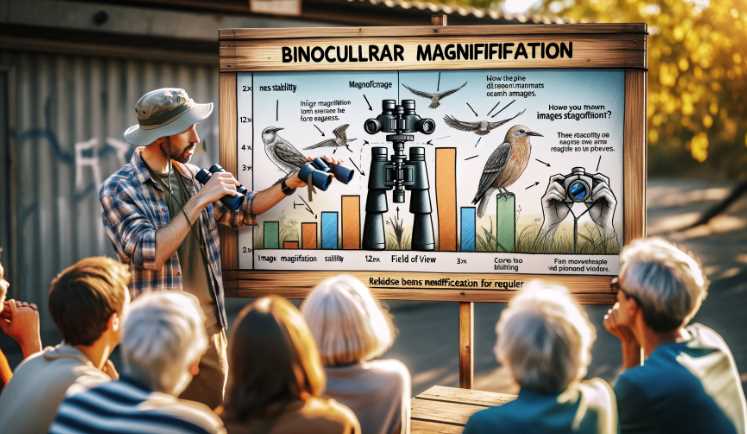In my countless ventures into the great outdoors, the pivotal role of choosing the right magnification became apparent as I grappled with the dilemma of 12×50 versus 10×42 binoculars. The significance of magnification in binoculars is not merely technical; it’s a gateway to transforming mundane observations into immersive experiences.
Picture yourself standing at the crossroads of optical choices, each number on those binoculars telling a unique story. The 12×50 and 10×42 conundrum mirrors our decisions in the hunting– a choice between closer, detailed views and the liberating lightness of portability. Join me as we delve into the nuances of binocular specifications, unraveling the intricacies that will guide you toward making an informed decision, ensuring that every moment in nature is not just seen but truly experienced.

Unveiling the Dilemma: 12×50 vs. 10×42 Binoculars
Navigating the wilderness, I found myself at a crossroads—12×50 or 10×42 binoculars? The decision is not merely about magnification; it’s a nuanced choice that can define the quality of your outdoor escapades. Let’s break down the intricacies of each option to guide you in making the right decision.

Magnification and Detail
The 12×50 binoculars boast a higher magnification, promising a closer look at distant wonders. Imagine spotting intricate bird plumage or deciphering the details of a distant landscape. However, this power comes at a cost – a narrower field of view.
On the other hand, the 10×42 binoculars strike a balance, providing decent magnification while offering a broader view. This versatility is particularly advantageous for tracking dynamic subjects, making them ideal for activities like bird watching or sports events.
Portability and Comfort
Heading deeper into the woods or traversing challenging terrains, the weight of your equipment becomes a crucial consideration. The 10×42 binoculars, with a slightly smaller objective lens, are noticeably lighter. This reduction in weight translates to increased comfort during prolonged use, ensuring that your binoculars won’t be a burden on your neck or shoulders.
| Specification | 12×50 Binoculars | 10×42 Binoculars |
|---|---|---|
| Magnification | Higher magnification | Balanced magnification |
| Field of View | Narrower field of view | Broader field of view |
| Weight | Heavier | Lighter |
| Ideal For | Detailed observations | Versatile applications |
Low Light Performance
As dusk settles and the nocturnal creatures emerge, the light-gathering capability of your binoculars becomes paramount. The 12×50 binoculars, with their larger objective lens, excel in low-light conditions, making them a preferred choice for activities like stargazing.
In contrast, the 10×42 binoculars, while not as proficient in low-light situations, still offer a commendable performance, making them suitable for most daylight activities.
In the end, the choice between 12×50 and 10×42 binoculars boils down to your specific preferences and the nature of your outdoor pursuits. Whether you prioritize detailed observations or value portability and versatility, understanding these nuances ensures that your binoculars become not just tools but extensions of your outdoor experiences.
Deciphering the Dilemma: Is 10×42 Better Than 10×50?
In the realm of binocular choices, the debate between 10×42 and 10×50 magnifications unfolds, each offering its unique advantages. Let’s delve into the intricacies of these options to guide you in making a decision that aligns with your specific needs.
1. Magnification and Objective Lens Size
The 10×42 binoculars, with a balanced magnification, strike a harmonious chord between detail and field of view. They are well-suited for a variety of activities, from bird watching to hiking, offering a versatile viewing experience.
On the other hand, the 10×50 binoculars, with a larger objective lens, excel in light-gathering capabilities, making them an ideal choice for low-light conditions, such as dawn or dusk observations. However, the increased size and weight may be a consideration for those prioritizing portability.
| Specification | 10×42 Binoculars | 10×50 Binoculars |
|---|---|---|
| Magnification | Balanced magnification | Enhanced magnification |
| Objective Lens Size | Moderate size | Larger size |
| Field of View | Decent field of view | Slightly narrower |
| Low Light Performance | Adequate | Excellent |
| Ideal For | Versatile applications | Low-light observations |
2. Portability and Comfort
When it comes to carrying your optical companion on outdoor adventures, weight plays a pivotal role. The 10×42 binoculars, being more compact and lighter, offer increased portability and comfort during extended use.
However, if the allure of enhanced light-gathering capability in low-light conditions is paramount, the slightly heavier 10×50 binoculars become a worthy companion.
How Far Can 20×50 Binoculars See?

In the quest for the perfect magnification, the allure of 20×50 binoculars beckons, promising to unveil the secrets of distant landscapes and celestial wonders. The question that echoes is, how far can they truly see? Delving into the specifics provides clarity.
1. Magnification and Objective Lens Size
With a powerful 20x magnification, these binoculars excel in bringing distant objects closer. The larger 50mm objective lens, while not as massive as some counterparts, strikes a balance between portability and light-gathering capability.
| Specification | 20×50 Binoculars |
|---|---|
| Magnification | Powerful 20x |
| Objective Lens Size | Moderate 50mm |
| Field of View | Narrower |
| Ideal For | Stationary observations |
2. Distance and Clarity
The effective range of 20×50 binoculars depends on various factors, including atmospheric conditions and the nature of the target. In optimal circumstances, these binoculars can extend your vision to impressive distances, making them suitable for observing details in landscapes or enjoying astronomical phenomena.
Which is Better: 80×100 or 12×50?

Entering the realm of extreme magnification, the choice between 80×100 and 12×50 binoculars poses a unique challenge. Let’s unravel the intricacies to guide you in making an informed decision tailored to your specific needs.
1. Magnification and Objective Lens Size
The 80×100 binoculars boast an astronomical magnification, opening a window to celestial wonders. However, the colossal size may limit their practicality for certain activities. On the other hand, the 12×50 binoculars offer a balanced experience, suitable for versatile outdoor pursuits.
| Specification | 80×100 Binoculars | 12×50 Binoculars |
|---|---|---|
| Magnification | Extreme 80x | Balanced 12x |
| Objective Lens Size | Large 100mm | Moderate 50mm |
| Field of View | Limited | Decent |
| Ideal For | Stargazing | Versatile applications |
2. Practicality and Versatility
While the 80×100 binoculars open a gateway to the cosmos, their bulk may limit mobility. The 12×50 binoculars, offering a compromise between magnification and practicality, prove versatile for a range of outdoor activities.
Are 20×50 Binoculars Better Than 10×50?

As I swap between 20×50 and 10×50 binoculars, the distinction becomes evident. The 20×50 magnifies the world, revealing intricate details, but it demands a steady hand. In contrast, the 10×50 provides a broader field of view, making it easier to track dynamic subjects. Whether observing wildlife or sports events, the choice hinges on the delicate equilibrium between power and stability.
1. Magnification and Stability
The 20×50 binoculars offer unparalleled magnification, ideal for stationary observations. However, the higher magnification requires a steady hand or additional support to avoid image shake. The 10×50 binoculars, with a lower magnification, provide a more stable viewing experience.
| Specification | 20×50 Binoculars | 10×50 Binoculars |
|---|---|---|
| Magnification | Powerful 20x | Balanced 10x |
| Stability | Requires steadiness | More stable |
| Ideal For | Stationary observations | Dynamic subjects |
2. Field of View and Application
The 10×50 binoculars, with their broader field of view, prove advantageous when tracking fast-moving subjects like birds in flight or sports events. In contrast, the 20×50 binoculars excel in scenarios where a detailed, stationary observation is the primary focus.
What Power of Binoculars is Best?
Selecting the right power for binoculars is a delicate balance, shaping the clarity and versatility of your observations. Let’s explore the considerations to guide you in finding the optimal power for your binoculars.
1. Magnification Range
Binoculars typically range from 8x to 20x magnification, each offering a unique viewing experience. The table below outlines the key characteristics of various magnification ranges:
| Magnification Range | Characteristics |
|---|---|
| 8x to 10x | Versatile, suitable for various activities |
| 12x to 16x | Enhanced detail, ideal for specific tasks |
| 20x and above | Extreme magnification, requires stability |
2. Practical Tips
- Consider Intended Use: For general-purpose use like bird watching or hiking, opt for 8x to 10x magnification. Higher magnifications are suitable for specialized activities like stargazing.
- Balance Power and Stability: Higher magnifications (12x and above) demand steady hands or additional support to avoid image shake. Consider this when choosing based on your stability preferences.
- Weight and Portability: Higher magnification often comes with larger lenses, making binoculars heavier. If portability is a concern, strike a balance between magnification and weight.
What is the Most Popular Binocular Size?
As I ventured into the world of binoculars, I discovered that certain sizes have captured the hearts of enthusiasts due to their versatility and performance. Let’s unravel the popularity of binocular sizes.
1. Popular Binocular Sizes
| Binocular Size | Characteristics |
|---|---|
| 8×42 | Versatile, balanced magnification and portability |
| 10×42 | Popular choice for various outdoor activities |
| 10×50 | Enhanced light-gathering capability, suitable for low-light conditions |
2. User Preferences
- 8×42: Embraced for its versatility, balancing magnification and portability, making it a go-to choice for various outdoor pursuits.
- 10×42: A popular all-around size, offering a slightly enhanced magnification for more detailed observations without compromising portability.
- 10×50: Sought after for its superior light-gathering capability, especially suitable for low-light conditions like dawn or dusk observations.
Tips for Choosing Binocular Magnification
As you embark on the journey of selecting binocular magnification, a few practical tips can illuminate the path to the perfect pair.
1. User Tips for Binocular Magnification
| Tip | Description |
|---|---|
| Consider Activity Type | Tailor magnification to your specific activities. |
| Test Before Purchasing | Try different magnifications to find your preference. |
| Seek Expert Advice | Consult experts or experienced users for guidance. |
2. Practical Considerations
- Activity-Specific Magnification: Choose magnification based on your primary use, whether it’s bird watching, stargazing, or sports events.
- Testing Before Purchase: Before committing to a purchase, test different magnifications to find the one that aligns with your visual preferences.
- Expert Consultation: Seek advice from experienced users or optical specialists to gain insights into the best magnification for your intended activities.
Final Words
As we conclude this exploration into the realm of binocular magnification, let these insights guide you towards choosing the perfect pair that aligns with your unique preferences and outdoor pursuits. Whether you find solace in the versatile 10×42 or opt for the detailed observations offered by the powerful 20×50, the world of optics is yours to discover.
Resources and References
- Cornell Lab of Ornithology – Binocular Basics
- Optics Planet – Binocular Buying Guide
- The Spruce – How to Choose Binoculars

I am an enthusiastic student of optics, so I may be biased when I say that optics is one of the most critical fields. It doesn’t matter what type of optics you are talking about – optics for astronomy, medicine, engineering, or pleasure – all types are essential.
Last update on 2025-10-22 / Affiliate links / Images from Amazon Product Advertising API
Table of Contents





Pingback: Exploring the Possibility: Is it possible to reduce the magnification of binoculars?
Pingback: What binocular magnification is best for astronomy?